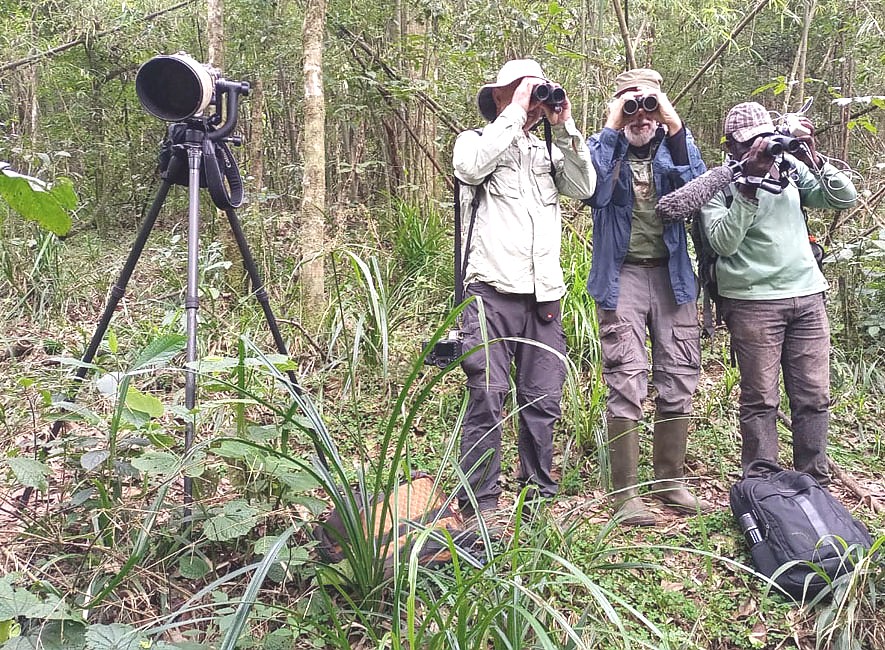


Tanzania Forest Services (TFS) plays a vital role in fostering both education and research through its ecotourism initiatives. By leveraging the rich biodiversity of Tanzania’s forests, TFS creates unique opportunities for learning and discovery, benefiting local communities, tourists, and researchers alike. TFS-managed forest reserves, are ideal settings for environmental education and scientific research, offering insight into sustainable forest management, conservation practices, and the vital role forests play in the broader ecological landscape.
One of the primary goals of TFS’s ecotourism initiatives is to raise awareness about the importance of forest conservation and sustainable land use practices. Through guided tours, interactive learning experiences, and nature walks, visitors are educated on the delicate balance of forest ecosystems and their significance to the environment.
Eco-Tourism Programs: TFS runs various educational programs that allow visitors to engage with local ecosystems. These programs often include guided tours by expert ecologists and forest rangers who explain the biodiversity of the region, the functions of forest ecosystems, and the impact of human activity on the environment. Educational walks provide valuable insight into topics such as tree species identification, conservation techniques, and ecosystem services.
Interpretive Signage and Displays: In TFS-managed areas, well-placed signage and interactive displays provide educational content on local flora and fauna, sustainable tourism practices, and climate change. These educational materials help deepen visitors' understanding of forest ecosystems while encouraging responsible tourism practices.
Workshops and Awareness Campaigns: TFS collaborates with local communities and schools to organize workshops and awareness campaigns about the importance of protecting Tanzania’s forests. These programs often involve hands-on activities, such as tree planting events or school visits to educate the younger generation about environmental conservation.
TFS-managed forests are rich in biodiversity and offer scientific research opportunities in areas ranging from conservation biology and climate change to forestry management. These forest reserves serve as natural laboratories where researchers can study various aspects of ecosystems, contributing to a better understanding of forest dynamics and how they respond to human activities, climate change, and natural processes.
TFS works closely with academic institutions, local universities, and international research organizations to facilitate scientific research. Partnerships with institutions like University of Dar es Salaam and Sokoine University of Agriculture allow researchers and students to conduct studies within the diverse forest ecosystems under TFS management.
TFS’s approach to ecotourism also involves local communities in educational and research activities, ensuring that they benefit both directly and indirectly from forest conservation efforts.
TFS places significant emphasis on educating the younger generation about the importance of forest conservation and sustainable natural resource management. By engaging youth in environmental education initiatives, TFS helps cultivate a future generation of environmental stewards.
Ecotourism managed by TFS is not only about attracting visitors but also about educating them. The experience of visiting Tanzania’s forests offers tourists valuable insights into the importance of preserving the country’s rich natural heritage. As tourists explore the nature reserves and learn from knowledgeable guides, they leave with a deeper understanding of conservation issues and a personal connection to the environment.
Eco-friendly Practices: TFS promotes low-impact tourism where visitors are educated on how their actions can affect the environment. Tourists learn about the importance of reducing their ecological footprint, supporting local communities, and respecting wildlife and natural habitats during their visit.
Sustainable Tourism Advocacy: Through ecotourism, we also raises awareness about the broader environmental challenges facing Tanzania’s forests, such as deforestation, illegal logging, and climate change. This awareness often motivates travelers to support sustainable practices in their own lives and advocate for global conservation efforts.
Education and research are fundamental pillars of TFS’s ecotourism strategy, contributing to a greater understanding of Tanzania’s forest ecosystems and promoting long-term sustainability. Whether it’s through educational programs for visitors, scientific research into biodiversity and climate change, or partnerships with local communities, TFS’s efforts in education and research are integral to conserving Tanzania’s forests and ensuring that future generations can enjoy and benefit from them. Through these initiatives, TFS not only protects Tanzania’s natural heritage but also fosters a more informed and engaged public, both locally and globally.
Tanzania’s Tanzania Forest Services (TFS) manages some of the country’s most pristine and ecologically significant nature forest reserves, offering photographers an incredible canvas for capturing the wild beauty of Tanzania’s forests, mountains, and landscapes. These lesser-known reserves provide a more serene and intimate experience compared to national parks, making them ideal for those who seek to capture unspoiled nature in its most raw and natural state.
TFS-managed nature forest reserves offer a diverse range of ecosystems—from tropical rainforests to montane woodlands, and rugged mountain terrains. For photographers, this variety presents an extraordinary opportunity to explore different genres of nature photography, from wide-angle landscape shots to intimate close-ups of flora and fauna, all set against stunning natural backdrops.
Here’s an exploration of the top reasons why TFS-managed nature forest reserves are perfect for photography:
Lush Forest Landscapes and Vistas
Our Reserves offer vast, unspoiled landscapes that are perfect for wide-angle shots of dense, tropical forests, rolling hills, and striking mountain backdrops. The dense forest canopy, mist-covered valleys, and distant peaks create dramatic scenes that photographers will cherish.
-Forest Canopies and Viewpoints: The towering trees and thick undergrowth in these forests offer an abundance of opportunities for capturing the grandeur of nature. Photographers can frame their shots to include the vast, layered canopy that stretches over the forest floor. Look for elevated viewpoints along hiking trails or near mountain ridges to capture sweeping vistas that showcase the scale and beauty of these forests.
-Mist and Morning Light: Many of these forest reserves are frequently shrouded in mist in the early morning hours. The soft light filtering through the mist creates a mystical, dreamlike quality in photographs. Early risers can capture this atmospheric light and the intricate details of dew-covered plants and trees.
Diverse Flora and Unique Plant Life
The rich diversity of plant life in TFS-managed nature forest reserves makes them a treasure trove for photographers who specialize in close-up shots of flora.
-Endemic and Medicinal Plants: Many of Tanzania’s forest reserves are home to endemic species, including rare and medicinal plants that are not found anywhere else in the world. The Udzungwa Mountains, in particular, boast incredible biodiversity, including endemic tree species and wildflowers that photographers can capture in intricate detail.
-Rainforest Vegetation: In the tropical forests of e.g Meru and Rungwe, the thick vegetation, from ferns to towering trees, offers a rich array of textures and colors. Photographers can explore different techniques to capture the varying shades of green, the interplay of light and shadow through the leaves, and the damp, glistening surfaces after rainfall.
-Macro Photography: For those with a keen eye for detail, these forests provide an excellent opportunity for macro photography. Close-up shots of moss, fungi, lichen, and delicate flowers or insects can reveal the beauty and complexity of forest ecosystems.
Mountain and Forest Photography
We often sit at the base of mountains or on their slopes, offering dramatic photographic opportunities for capturing both the forest and mountainous landscapes. The varied terrain creates a perfect contrast between verdant forests and rugged, rocky peaks.
-Mountains in the Mist: The forests surrounding the likes of Mount Meru and Rungwe Mountain provide unique opportunities to capture mountains partially veiled by mist, creating dramatic compositions. As the fog rolls in and out of the valleys, photographers can play with long-exposure techniques to convey movement in the mist and clouds, capturing the ever-changing moods of the landscape.
-Summits: Photographers can also explore higher altitudes for sweeping views of the forests below, often capturing the contrast between dense woodlands and expansive skies. The hike to Mount Rungwe’s summit, for example, offers panoramic views that are perfect for wide-angle landscape photography.
Wildlife and Bird Photography
Although TFS nature forest reserves are primarily known for their forests, many are home to a rich diversity of bird species, small mammals, and other wildlife, making them ideal for wildlife photographers who focus on flora and fauna outside of traditional safari experiences.
-Birdwatching and Avian Photography: Our Reserves are known for their birdlife, with several endemic species. Photographers can capture the rare white-cheeked turaco or green-headed oriole among the forest canopy, using telephoto lenses to focus on colorful, fast-moving birds. The dense foliage also provides the perfect backdrop for dramatic shots of birds in flight or perched on trees.
-Insects and Small Mammals: In addition to birds, these forest reserves host a variety of small mammals, insects, and amphibians that can be photographed in action. For instance, capturing the mossy toads in the damp rainforest floor or photographing butterflies and beetles among the foliage can offer unique perspectives on life within the forest.
Water Features and Cascading Waterfalls
The Meru, Rungwe, Kalambo and Udzungwa are known for their beautiful waterfalls, rivers, and streams, which are perfect for photographers looking to capture movement and reflection in their images.
-The centerpiece of Duluti’s beauty is Duluti Lake, a small but mesmerizing crater lake surrounded by verdant forest. Early mornings offer misty scenes as the mist rises off the lake’s still waters, creating a dreamlike atmosphere perfect for capturing long-exposure shots of the lake. The reflection of the surrounding forest in the calm water adds depth to landscape photos, while the towering Mount Meru in the background offers a dramatic backdrop for panoramic shots.
Dramatic Lighting and Shadows
The dense canopy of the forests creates a play of light and shadow, offering a unique challenge and opportunity for photographers.
-Dappled Sunlight: As sunlight filters through the forest canopy, photographers can use the contrast between light and shadow to create dramatic compositions, capturing how the sun’s rays filter through gaps in the foliage. The interplay of natural light and shadows across the forest floor or on the trunks of trees can be used to highlight texture and depth in photographs.
-Golden Hour and Sunset Shots: Early morning and late afternoon, particularly in areas with higher elevation, can offer stunning golden hour light, where the sun casts a warm, soft glow over the landscape. Photographers can take advantage of this time for magical sunset and sunrise shots, capturing the ethereal beauty of the forest bathed in golden hues.